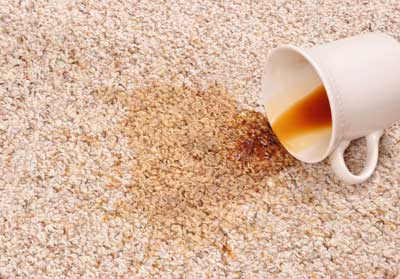How To Clean Food Stains from Carpet
Food stains are tricky because they are combination stains. Most foods are acidic, some like coffee and tea containing tannins, some are greasy, and none of them are things that you want to see on your carpet. Fortunately, there are techniques for dealing with all the aspects of these stains. Keep in mind that carpets come in a wide variety of materials, and unusual carpet pigments or materials such as leather, suede or exotic synthetics may not react favorably with cleaning solutions. Wool and silk can also require specialized care, and are particularly ill suited to enzymatic or alkali based solutions. You may also wish to consider the backing material of your carpet or rug, and whether or not it will react to the cleaning solution. Any stain remedy should be tested in an inconspicuous area. When at all possible, treat the food spill promptly. Old food stains can also benefit from these techniques, but may be more resistant than stains that are freshly treated. If the stain resists repeated treatments, professional assistance may be required.

For combination stains, use the remedies cyclically, with an intermediate overall cleansing with a mild pH neutral dish detergent diluted with water. This will aid in breaking up and lifting away the stain, as well helping to prevent the cleaning solutions themselves from adversely affecting the carpet or rug. Note that silk rugs can be damaged by water, and may require treatment with dry-cleaning remedies only, or professional assistance.
First remove as much bulk material as you can. Use blotting rather than rubbing motions to avoid spreading or otherwise worsening the stain. You may find it helpful to use a plastic butter knife or other blunt plastic tool. Apply an enzymatic contact lens cleaner, or unseasoned meat tenderizer dissolved in water, to the stain using cotton balls or a clean rag. The enzymatic cleaner will address the protein content of the stain. Certain types of protein stains containing egg and various dairy products can be allowed to dry before treatment, enabling the removal of additional stain solids. Next apply vinegar using a clean rag and blotting motion. This will help break up the acids in the food stains. Follow with a mild pH neutral dishwashing liquid diluted with water, to carry away foodstuffs and the various solvents. Repeat cycle as needed. If the stain is hardening, or contains tannins, it may be helpful to dab it periodically with a cotton ball soaked in glycerin. Once the stain appears alleviated, address any potentially greasy residue with a cleaning solution made from 1 TB of Oxyclean or similar sodium carbonate based cleanser and 1 quart of water. Apply the solution to the affected area using a damp sponge and blotting motion. Follow with a clear water rinse and blot dry or use a wet/dry vacuum to remove excess moisture.
Caution: Never mix cleaning agents or chemicals, the result can be dangerous or deadly. Before cleaning, always test the agent on an inconspicuous location to determine its suitability and to make certain it does not damage the material. Wear appropriate clothing such as gloves and protective eyewear, and work in a well-ventilated area. Accidental inhalation or ingestion of cleaning agents can be hazardous and even fatal, particularly to pets and children.





